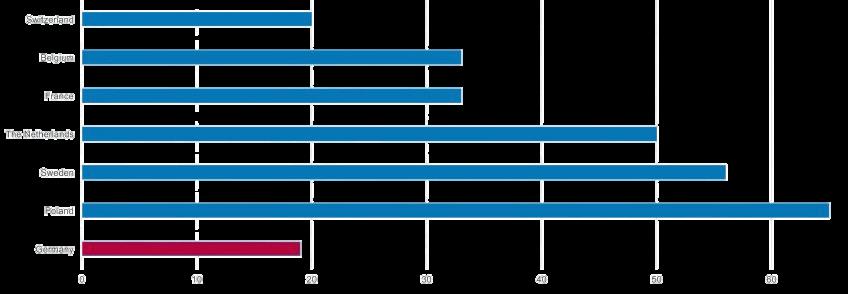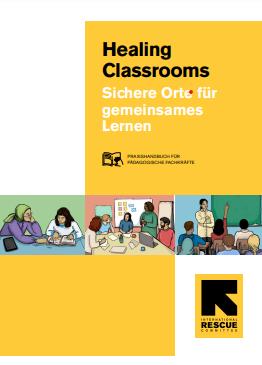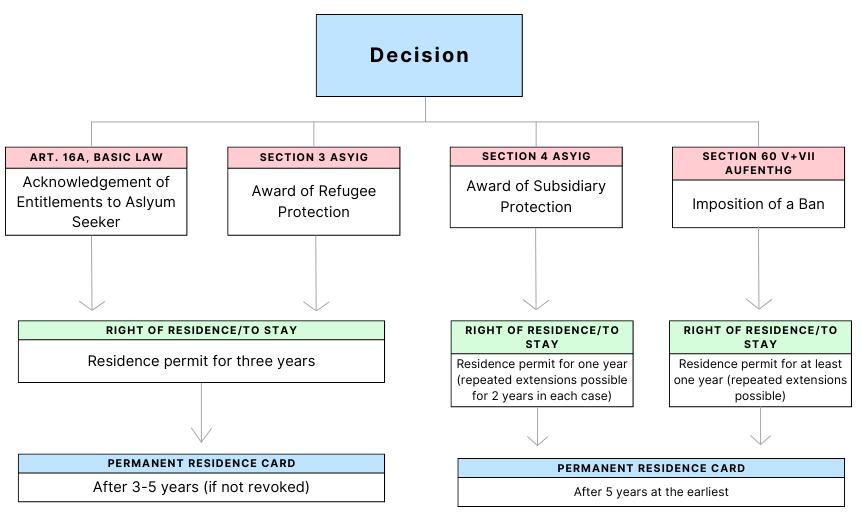

BACKGROUND BACKGROUND BACKGROUND
Council Directive 2001/55/EC adopted in aftermath of Yugoslavian war
TPD first activated March 4, 2022 due to Russian invasion of Ukraine, forcing 5.7 million to flee in <1 year
TEMPORARY PROTECTION DIRECTIVE
80 are female FOR UKRAINIANS IN GERMANY AND
Khrystyna Kozak MGA‘25 & Ethan Chiang ‘27
PROFILE

FUNDS & BENEFITS
Beneficiaries of Temporary Protection (BTPs)*
Bürgergeld Social welfare Refugee Status 20-25% less
Asylum Seekers’ Benefits Act
*$6B allocated for BTPs in German 2024 budget
SOLIDARITY? unequal
EUROPE

Based on UNHCR Regional Protection Profiling & Monitoring
% 2% have refugee status, compared to 85% with TPD
41% are employed (excluding elderly and minors)
40% lack access to childcare
71% are renting their accommodation or hosted by relatives
COMPARING PROTECTION CATEGORIES
Access to... Housing Labor Market
Duration Family Reunification
tpd refugee status
Yes, but many live in private accomodations
Yes, but de-jure provisions ≠ de-facto engagement
No
Maximum of 3 years (so far)
POLICY RECOMMENDATIONS
No (during asylum seeker status)
No (during asylum seeker status)
Yes
No limit on time; can not be revoked
ACCESS TO BENEFITS
Social welfare scheme for BTPs allows for better access to labor market infrastructure
However, employment rate in Germany is comparatively lower than other EU states


Due to highly regulated labor market and long/convoluted bureaucratic procedures
Housing market is also currently in a crisis, leading to an increasing amount of Ukrainians ending up in initial reception centers

Narrative that TPD was invoked for Ukrainians (and not Syrians, Afghanis, etc.) due to racial discrimination


Activation in 2022 was due to urgency and scale of humanitarian crisis (took 4 years for Syrian situation to reach same level of displacement)
Invidious comparison----in comparing solidarity for both groups, timeframes need to be equivalized





Extend TPD by 1 year, while finding other solutions (ex. long-term residence)
Include Ukrainians in decision-making
Consider positive secondary movement, change facultative parts of TPD





Advocate for TP scope of rights for other nationalities 1# host of Ukrainians (1.13M)
Raise awareness on differing protection statuses
Make a lesson-learnt from integration challenges for Syrians



Research solidarity patterns

Use data to prove or disprove the role of race in activation of TPD
Research whether allocation of benefits across categories is unequal relative to # of people

SPECIAL THANKS TO:
Ukrainian Refugee Women’s Integration Into the German Labor Market
What is the current status of Ukrainian refugee women’s integration into the German labor force? What measures has the government taken to bolster this process and what barriers are they failing to address?
TPD = Refugee Status
All Ukrainian nationals arriving in Germany are being granted temporary protection under the Temporary Protection Directive (TPD). Rights granted under TPD: A residence permit valid for up to 3 years (has now been extended to March 4th, 2025)
Access to employment, social welfare, housing, healthcare, and schooling for children under 18

Characteristics of Ukrainian Refugee Women MANY

Germany’s Childcare Crisis: The Path Forward
Aria Bossone, Vannesa Campuzano Villalobos, and Catherine Schafer
Current Government Involvement
MY TURN - Women with Migration Experience Power Up (Frauen mit Migrationserfahrung starten durch)
MiA - Migrant Women Simply Strong in Daily Life (Migrantinnen einfach stark im Alltag)
Integration courses (Integrationskurse)
Job-Turbo initiative and supplemental vocational language courses (Berufssprachkurse)
Barriers to Labor Integration
CHILDCARE IS A RIGHT.
Although all children are entitled to a spot in Kita according to German law and TPD, there is a shortage of 430,000 daycare placements due to a lack of childcare workers, failing to meet parental needs. Since most arrivals from Ukraine are women with children, often without their partners, the availability of adequate and affordable childcare is considered a precondition for refugee women’s labor market integration.
To meet the childcare needs of families in Germany by 2030, systemic changes need to be made now. We propose that these systemic changes start by increasing the desirability, value, and accessibility of childcare labor, both socially and financially.
Germany must realize childcare matters for building human capital, and relates to issues including women’s employment, family welfare, child development, business productivity, and the economy.
Spring 2024
Europe Confronts the Refugee Challenge
A DIFFICULT RECOGNITION PROCESS LACK OF COUNSELING SERVICES GERMAN LANGUAGE ACQUISITION LACK OF CHILDCARE
LEVELS OF EDUCATION VAST UNEMPLOYMENT
3
W/YOUNG CHILDREN HIGH
1 2
Refugee Students in
German
Classrooms: Teacher Stereotypes and Efforts to Overcome Them
Stereotype Threats (STs)
Stereotypes in German Schools
Theory
Stereotype Threat (STs): fear that someone’s academic performance will validate existing negative stereotypes about their group
Stereotype Suppression 1. Preventive Focus 2.
Stereotype suppression and preventive focus produce a range of behavioral shifts among students:
Negative emotional regulation
Slow automation of cognitive tasks
Impaired information processing Social-Psychological

Forms of Stereotypes Academics

STs Interfere with Learning and Performance

Why is this phenomenon important? STs could contribute to group differences in developed academic ability.
Refugee students are demanding. Refugees have poor academic backgrounds. Refugee students lack German language proficiency. Leads to less participation
Language Culture Security
Conflict of norms
Religious differences

3 Anti-Stereotype Teacher Training
Important Course Categories:
Language Education
Cultural Diversity
Resilience/Psychosocial Training

University Courses
6 of 16
German states require courses in language education for all students receiving teaching degrees.
Refugee students are more prone to violence and radicalization.

reotype Content of Refugee Subgroups in Germany

25 of 70
Professional Development Opportunities and Training Material
Many actors offer relevant continuing education
German universities that educate teachers do not offer courses preparing teachers for a diverse classroom courses
Teachers have difficulty finding courses and joining them.
These courses are in high demand and are often not entered into catalogs of central course offerings
Organizations have started to circulate highquality training material and lesson plans; however, teachers report a continued shortfall.
Source: European Journal of Soc al Psycho ogy, 2019
Teacher Associations Re g ous Organiza ions Government (Federa State Local NGOs Schoo s Un versit es
Souce Steele 1997 Source: Tay or, Lauren, 2011
Young Negalegne Mandefiro
Lillegard Requ red Requ red fo Teachers o German No Requ red
Matthew
John
Source Morr s-Lange et al , 2016 ECRC Spring 2024

Unravelling Refugee Health Challenges: an Overview
Genevieve Jackson and Poulomi Ghosh
Health Issues Faced on the Journey : Breakdown of Refugees in Germany
• The medical issues most seen onboard rescue vessels from SeaWatch: fuel burns, lung edema from fuel inhalation, hypothermia, seasickness, dizziness, dehydration, scabies, trauma
• SeaWatch embarks pregnant women from early to late pregnancy, occasionally also giving birth on rescue vessels
• Health care spending is covered by SeaWatch’s overall budget, so a large amount of donations are directly used for onboard health equipment
Syrian Refugee Health Profile
Anemia:
48.4% of Children ≤5 years old
44.8% of Women, 15-49
Arthritis
• 7.1% of adults ≥18 years old
Mental Health
Hypertension:
10.7% of adults ≥18 years old
6.1% of adults ≥ 18 years old
• Women’s health to be impaired by post migration stressors: perceived discrimination, loss of social status and future anxieties
• Many refugees feel disempowered and incompetent regarding navigating the German healthcare system, lacking information and not understandingtheir full rights and options under the health insurance plan
• Many refugees feel that doctors do not take their symptoms seriously
Healthcare Received upon Arrival
Asylum seekers are housed in reception centers or collective accommodationsand undergoregular medical check-ups.
Refugees and asylum seekers have the right to receive vaccinationsupon arrival, irrespective of their duration in the country.
Doctorsmay conduct additionalanalyses to assess their health status thoroughly.
This examination includes X-ray of respiratoryorgans, blood, and skin tests, especially for individuals under 15 years old and pregnant women.
Asylum seekers in Germany undergo mandatorymedical examination for communicable diseases upon entry, as per the Federal Asylum ProcedureAct
Receiving Refugee Status

Healthcare access varies based on citizenship and country of origin.
The government covers insurance costs for refugees and asylum seekers
Addressing the Lack of Research
• There is no disaggregation of data between men and women in these sectors
• The ratio of Syrian men to women entering Germany through unconventional routes is 10:1 due to travel difficulties and restrictions on women
Authorities prioritize healthcare access for individuals likely to receive refugee status
Syrian refugees generally find it easier to access healthcare compared to Afghan refugees
Syrians typically receive refugee status faster than Afghans or Africans, resulting in quicker access to health cards, as demonstrated by Mr. Badwi's case.
Asylum seekers are issued yellow cards, granting specific healthcare services, which are later upgraded to full benefits upon receiving refugee status, akin to German citizens
• Women often enter with marriage or student visas, granting them proper health insurance plans
• Health care is usually sought from house doctors rather than publicly funded doctors
• Arabic-speaking female house doctors are preferred over German doctors due to cultural compatibility
• Important because women make up half of the population and maternal health directly impacts future generation health
A B A B
A B A B
535
C
B C A B
B C
C A B
Diabetes
Anxiety: 40% Depression: 31%
Circulatory System Disease: 50.6% of Ukrainians surveyed 8.2% of the total population Heart Disease, coronary artery clogging, strokes Endocrine Diseases 24.9% of Ukrainians surveyed 4% of the total population High prevalence of hypothyroidism and metabolic disorders, which could be due to the 1985 Chernobyl accident and the subsequent lack of mandatory salt iodization Digestive System Diseases
of Ukrainians surveyed 1% of total population Chron’s disease, inflammatory bowel disease, inflammation of the small intestine Respiratory System Diseases 6% of Ukrainians surveyed 0.9% of the total population Lung cancer, Sars-Cov2 Mental Health 33% of Ukrainians deal with mental health disorders, one of the highest rates in the world 28% 41% 31%
• PTSD: 31% Ukrainian TPD Health Profile
6.2%
Syrians Ukrainians Other nationalities

Unraveling Refugee Health Challenges: An Emphasis on Women's Health
Meera Bhakta, Alex Jensen
Nanovic Institutefor European Studies


Policy Recommendations:
1. Multi-Language Access: Ensure language interpretation services are readily available in healthcare settings to overcome language barriers for refugee women.
2. Cultural Competence and Trauma Informed Training: Implement mandatory cultural competence training that includes trauma informed training for healthcare providers to improve their ability to serve refugee women effectively.
3. Intercultural Community Health Workers: Support the role of community health workers from refugee backgrounds who can provide culturally sensitive guidance and advocacy for women's health.
Further Research:
Barriers to Access: Investigate the specific barriers that prevent refugee women from accessing women's health services. This could include language barriers, cultural differences, lack of awareness about available services, stigma, transportation issues, or financial constraints.
Cultural Competence: Examine the cultural competenceof healthcare providers in Germany. Assess their ability to understandand address the unique needs of refugee women, includingissues related to trauma, cultural beliefs about health and wellness, and gender-specific health concerns.
Community Outreach and Education: Explore the effectiveness of communityoutreach and education programs aimed at informing refugee women about available women's health services. Evaluate the impact of these programs on increasing awareness, reducingstigma, and improving access to care.
Integration Policies: Analyze the integration policies in Germany that may impact refugee women's access to healthcare. This could include policies related to language education,employment opportunities,housing stability, and social support networks.
Healthcare System Navigation: Investigate the ease of navigating the German healthcare system for refugee women. Identifyany bureaucratic hurdles, administrative complexities, or lack of guidance that may hinder their ability to access and utilize women's health services.
Collaborative Partnerships: Explore partnerships between healthcare providers, community organizations, advocacy groups, and refugee support networks. Evaluate how these collaborations can enhance outreach, coordination of care, and holistic support for refugee women's health needs.






































